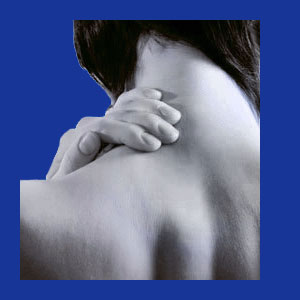
Neck flexion pain occurs when the patient looks downwards, elevating the occiput and lowering the chin towards the chest. Neck flexion is a normal movement for humans and should not be painful, as long as the limit on the cervical spinal range of motion is respected. However, many people do complain of flexion-related neck and upper back pain, often indicating the presence of some pathology in the cervical spine or surrounding musculature.
Neck pain when looking downwards is relatively common. It can be a direct result of injury or spinal degeneration, but in most cases involves the neck muscles and ligaments, rather than the vertebral and intervertebral structures of the neck. Symptoms range from mild and irritating to completely debilitating.
This dialog further details our coverage of flexion upper back and neck pain. We will discuss important information that expands on our previous coverage of neck pain when looking down.
Neck Flexion Pain and Neck Whiplash or Strain
Whiplash is a very common type of neck injury. Although most often associated with car accidents, sports injuries and falls, whiplash can actually occur for many reasons, some of these as innocuous as sneezing. Whiplash-type symptoms can also result due to cumulative strain on the neck muscles, most often diagnosed as RSI.
In many cases, we see patients who report the classic pain of whiplash, but do not indicate any trauma to their neck. They deny impacts, accidents or injury of any type, yet present acute expressions of flexion neck pain. We tend to see this more and more in people who work at computers or spend inordinate time on a mobile electronic device. The cumulative postural strain associated with long hours of leaning the head forward can cause injury to the interspinous ligaments, neck muscles and even the spine itself over time.
Muscles tend to develop imbalances and the weight of the head, held forward for long timeframes, degenerates soft and spinal tissues alike.
With the dependence on electronic devices, we see an increasing number of patients presenting these symptoms each year. Unless serious changes are made to the way people work and play with their devices, we expect this trend to worsen until forward head posture becomes an international health crisis.
Lesser Known Causes of Flexion Pain
We have seen a variety of lesser known contributors to flexion-related neck pain from both the structural and psychological realms. Below, we detail a few of the most significant of these factors to help patients and diagnosticians better understand how these pain syndromes can originate:
Some people tend to curl into a ball when sleeping in the fetal position. When the chin is tucked in night after night, RSI can occur in the neck, similar to the manner in which strain can occur from a forward head posture while standing or sitting. This is particularly true if the patient utilizes a poor quality or ill-fitting pillow or is tense when sleeping; haunted by subconscious anxieties.
We have found that psychological stress combined with forward head posture is particularly damaging and pain-inducing. People who drive with forward head posture (a sign of aggression) or work with forward head posture, combined with stress, often suffer acute attacks of flexion-related pain recurrently.
Martial artists, boxers and some other types of athletes tend to tuck the chin and raise the occiput to protect their face. Over time, this can lead to strain, particularly when combined with the brute force of violent blows directed at the head and neck.
Neck Flexion Pain Relief Tips
For minor muscular strain and mild structural changes causes by an injury, accident or RSI condition, the patient can usually successfully resolve the pain using conservative home care modalities:
First, postural assessment and adjustment might be necessary. Although this process can be painful in itself, learning to work and play with proper ergonomics will save you lots of suffering in the future.
Patients should give some thought to the positions they utilize to sleep, watch television and do anything and everything that might create strain on the neck. A bit of proactivity in this regard can go a long way.
Next, the patient is strongly encouraged to take better stock of their psychoemotional state and get in touch with the power the mind has to create tension, and therefore pain, in the body. Patients are encouraged not to repress or suppress thoughts, feelings or sensitivities. A course of knowledge therapy can be both preventative and therapeutic for neck pain sufferers.
Physical therapists are excellent resources for learning how to counteract strain using stretches and exercises to increase the strength and flexibility in the neck and upper back. Hiring a PT to teach you these tactics is far more constructive and will serve you better than simply taking pain medications.
For acute presentations of pain, with that notorious pulling sensation in the back or neck, try ice for the first 48 hours, followed by wet heat. Massage will help, as might chiropractic, acupuncture or TENS. We tend to stick with ice, heat and massage as the best modalities for muscular strain problems that are responsible for the overwhelming majority of flexion-related neck pain and upper back pain syndromes.





